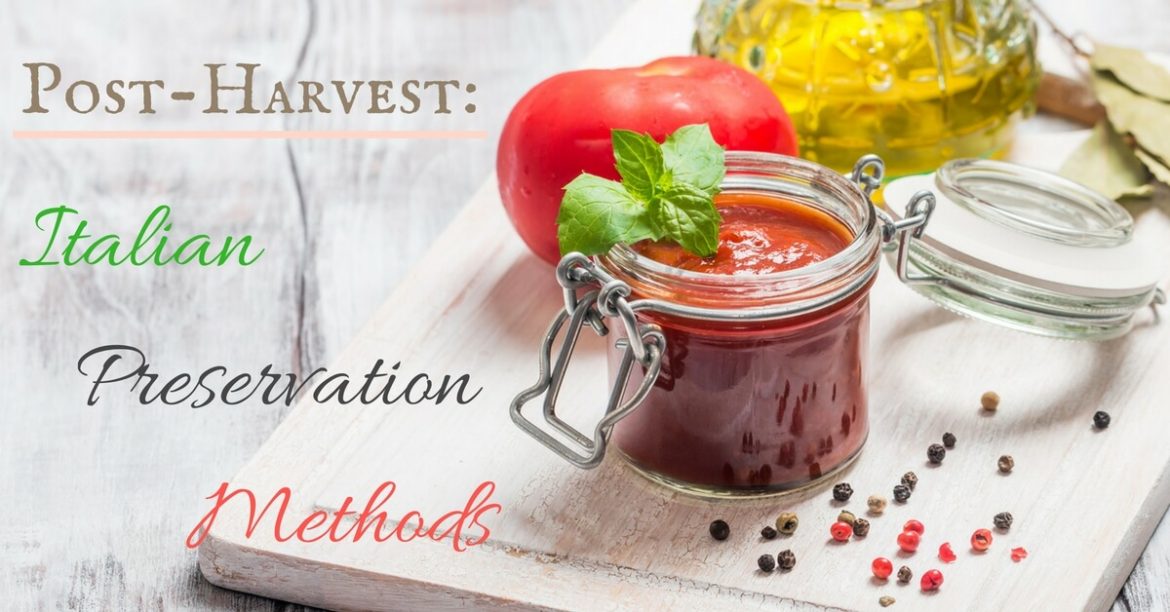- Tomatoes: A Taste of Summer - July 26, 2017
- The International Origins of Pasta - July 12, 2017
- A History of Italian Americans in Salt Lake City - June 29, 2017
Now that we’re nearing the end of October, harvest time has ended and traditionally, this is when people begin preserving foods. A lot of Italian culinary traditions and favorite foods come from historical methods of preservation, from cheeses to dry-cured meats to wine.
Preserving foods ensure that the bountiful harvest does not go to waste. At the same time, the process of preservation adds depth of flavor and texture to foods. We’ll explore a few different preserved foods after the harvest and see how they’re used in Italian cuisine today.
Tomatoes
Tomatoes, tomatoes, tomatoes. The quintessential Italian produce! Tomatoes are mostly harvested in summertime, tough there may be some that linger in warm autumns. The most well-known and traditional mode of preserving fresh tomatoes is passata di Pomodoro – or passata for short. Passata is a tomato puree that has versatile uses, from the base of a pasta sauce to being used in a stew or soup. Passata takes some time to prepare, but its preservation methods are not complicated.
Fresh tomatoes are cut up and placed into a pot, sprinkled with a bit of salt, and then simmered over heat until they soften and melt. Some preparations may include onion, carrot, and celery. After everything has softened, the tomatoes are passed through a food mill with the smallest holes. The liquefied tomatoes are then cooked for another half hour or so, until it appears silky and no longer watery.
The passata is then transferred to clean jars, and then they are stored overnight under a warm blanket. This method pasteurizes the passata; the heat ensures that the jars are hermetically sealed. Passata may be stored for about a year with this method – and the brightness of the tomato adds a spot of warmth through cold winters.
Olive Oil
Olive harvests typically occur between November and January, but could begin as early as September. The time of harvest reflects the maturity of the olive and thus affects the flavor of the olive oil. Each olive is 20% oil – and in some cases, one liter of oil may require more than 200 olives. Timing is very important with olive pressing, as the fruit could quickly spoil.
For example, in Tuscany, early harvesting of less-ripe olives produces an olive oil that is prized for its peppery flavor. Traditionally, olives are pressed at a communal mill, called a frantoio. Olive growers bring the fruits of their labor here to be pressed – and this centuries-old tradition continues to do this day in Tuscany.
Wine
Vendemmia is the name for the grape harvest, and it often takes place in mid to late September. Like olives, grapes must also be quickly processed shortly after harvest, as the fruit could ferment prematurely. After harvesting, grapes are broken up, whether by mechanical means or with traditional wooden tools. By smashing up the grapes, the juices and sugars are released and thus the fermentation process begins. The liquid is then stored in stainless steel vats until it stops bubbling (this means the fermentation process has finished), and then it is transferred to the glass bottles we recognize!
Vegetables
From artichokes to peppers to onions to cauliflower to carrots, there is a long tradition of preserving vegetables in oil and herbs. The various preserved vegetables are known as giardiniera. The vegetables are prepared – peeled and chopped up – while onions soak in water. Vinegar is set to boil with spices and herbs such as bay leaf, cloves, and peppercorn. The vegetables are then added, and simmer in the vinegar, until they are removed and placed into sterilized jars. The hot vinegar is then poured over the vegetables, and then the jars are tightly sealed. Giardiniera is then stored in a cool, dark place for a few weeks, until they’re ready to be consumed. Like passata, giardiniera lasts for about a year.
Hungry for an autumn time Italian meal? Come visit us at Cucina Toscana for a hearty meal.
Cucina Toscana in Salt Lake City
Come visit us for a great Italian feast. We look forward to serving you.
(801) 328-3463

